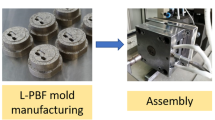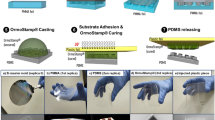Abstract
Injection moulding (IM) is a well-established manufacturing process for cost-effective replication of polymer-based components. Advanced IM processes have been developed; modifying the final polymer part produced to create microcellular structures. Through the creation of microcellular materials, not only can the final weight be reduced but also, the near net shape can be improved. Microcellular Injection Moulding (MIM) shows high potential to improve near net shape of polymer parts and, the green aspect of polymer manufacturing platforms. This chapter aims to present the significant developments that have been achieved to enhance the MIM technology. Aspects covered include co-injection moulding, core back processing, gas counter pressure, vario-thermal moulding and mould coating. The resulting characteristics of each enhancing technique is presented.
Access this chapter
Tax calculation will be finalised at checkout
Purchases are for personal use only
Similar content being viewed by others
References
Wong A et al (2016) Microcellular plastics. In: Encyclopedia of polymer science and technology. Wiley Inc., Canada, pp 1–57
Stevenson JF (1996) Innovation in polymer processing: molding. Hanser Pun Inc. pp 93–149
Martini-Vvedensky JE, Suh NP, Waldman FA (1984) Microcellular closed cell foams and their method of manufacture. U.S.A.
Xu J (2010) Microcellular injection molding. In: Nwabunma RFGAD (ed) Wiley series on polymer engineering and technology, 1 edn, vol 1. Wiley Inc, Canada
Xu J, Pierick D (2001) Microcellular foam processing in reciprocating-screw injection molding machines. J Inject Molding Technol 5(3):152
Pierick DE et al (2005) Injection molding of polymeric material. U.S.A.
Goldsberry C (2017) Trexel announces development of new MuCell-focused technical center. Plastics Today 2016 [cited 2017 8th Aug]. Available from: https://www.plasticstoday.com/injection-molding/trexel-announces-development-new-mucell-focused-technical-center/99870300224622
Habibi-Naini S (2004) Optifoam™—the flexible solution for foam injection molding. In: Blowing agents and foaming processes 2004. Blowing Agents and Foaming Processes, Hamburg, Germany
Michaeli W, Krumpholz T, Obeloer D (2008) Profoam—a new foaming process for injecting molding. In: Proceedings of the 66th annual technical conference of the society of plastics engineers, Milwaukee, Wisconsin, USA
Błędzki AK et al (2006) Microcellular polymers and composites. Polimery 51(10)
Bryce DM (1997) Plastic injection molding. Material selection and product design fundamentals. In: Bryce DM (ed) Fundamentals of injection molding series, vol 2. Society of Manufacturing Engineers, Dearborn, Michigan, p 354
Harper CA, Petrie EM (2003) Plastics materials and processes: a concise encyclopedia. Wiley, Canada, p 59
Colton JS (1985) The nucleation of microcellular thermoplastic foam. Massachusetts Institute of Technology, U.S.A.
Kumar V (1988) Process synthesis for manufacturing microcellular thermoplastic parts: a case study in axiomatic design. Massachusetts Institute of Technology, U.S.A.
Park CB (1993) The role of polymer/gas solutions in continuous processing of microcellular polymers. Massachusetts Institute of Technology, U.S.A.
Cha SW (1994) A microcellular foaming/forming process performed at ambient temperature and a super-microcelluar foaming process. Massachusetts Institute of Technology, U.S.A.
Baldwin DF (1994) Microcellular polymer processing and the design of a continuous sheet processing system. Massachusetts Institute of Technology, U.S.A.
Bryce DM (1996) Plastic injection molding. Manufacturing process fundamentals. In: Bryce DM (ed) Fundamentals of injection molding series, vol 1. Society of Manufacturing Engineers, Dearborn, Michigan, p 253
Goodship V, Arburg Maschinenfabrik Hehl und S, Limited RT (2004) Practical guide to injection moulding, 1st edn. Rapra Technology Limited, Shawbury, Shrewsbury
Broyer E, Gutfinger C, Tadmor Z (1975) A theoretical model for the cavity filling process in injection molding. Trans Soc Rheol 19(3):423–444
Rosato DV, Rosato DV, Rosato MG (2000) Injection molding handbook, 3rd edn. Kluwer Academic Publishers, Massachusetts
Lee JWS, Park CB, Kim SG (2007) Reducing material costs with microcellular/fine-celled foaming. J Cell Plast 43(4–5):297–312
Turng L-S, Kharbas H (2003) Effect of process conditions on the weld-line strength and microstructure of microcellular injection molded parts. Polym Eng Sci 43(1):157–168
Ivascu N, Fetecau C (2010) Dynamic temperature control in injection molding with new conformal heating/cooling system. Ann “dunărea de jos” of galaţi. Fascicle v( Technol Mach Build) 5–11
Bryce DM (1998) Plastic injection molding. Mold design and construction fundamentals. In: Bryce DM (ed) Fundamentals of injection molding series, vol 3. Society of Manufacturing Engineers, Dearbon, Michigan, p 182
Baldwin DF, Shimbo M, Suh NP (1995) The role of gas dissolution and induced crystallization during microcellular polymer processing: a study of poly (ethylene terephthalate) and carbon dioxide systems. J Eng Mater Technol 117(1):62–74
Goel SK, Beckman EJ (1994) Generation of microcellular polymeric foams using supercritical carbon dioxide. I: effect of pressure and temperature on nucleation. Polym Eng Sci 34(14):1137–1147
Burnham TA et al (2001) Method and apparatus for microcellular polymer extrusion. U.S.A.
Wu X et al (2008) A single-phase of supercritical CO2/polystyrene solution in foam extrusion. J Wuhan Univ Technol Mater Sci Ed 23(6):804–808
Colton JS, Suh NP (1987) Nucleation of microcellular foam: theory and practice. Polym Eng Sci 27(7):500–503
Park CB, Baldwin DF, Suh NP (1995) Effect of the pressure drop rate on cell nucleation in continuous processing of microcellular polymers. Polym Eng Sci 35(5):432–440
Kramschuster A et al (2005) Quantitative study of shrinkage and warpage behavior for microcellular and conventional injection molding. Polym Eng Sci 45(10):1408–1418
Doroudiani S, Park CB, Kortschot MT (1998) Processing and characterization of microcellular foamed high-density polythylene/isotactic polypropylene blends. Polym Eng Sci 38(7):1205–1215
Shaayegan V et al (2016) Identification of cell-nucleation mechanism in foam injection molding with gas-counter pressure via mold visualization. AIChE J 62(11):4035–4046
Shaayegan V, Wang G, Park CB (2016) Effect of foam processing parameters on bubble nucleation and growth dynamics in high-pressure foam injection molding. Chem Eng Sci 155:27–37
Shaayegan V, Wang G, Park CB (2016) Study of the bubble nucleation and growth mechanisms in high-pressure foam injection molding through in-situ visualization. Eur Polymer J 76:2–13
Wang G-L et al (2015) Research on formation mechanisms and control of external and inner bubble morphology in microcellular injection molding. Polym Eng Sci 55(4):807–835
**ao C-L, Huang H-X, Yang X (2016) Development and application of rapid thermal cycling molding with electric heating for improving surface quality of microcellular injection molded parts. Appl Therm Eng 100:478–489
Hou J et al (2017) A novel gas-assisted microcellular injection molding method for preparing lightweight foams with superior surface appearance and enhanced mechanical performance. Mater Des 127:115–125
Goel SK, Beckman EJ (1994) Generation of microcellular polymeric foams using supercritical carbon dioxide. II: Cell growth and skin formation. Polym Eng Sci 34(14):1148–1156
Seldén R (2000) Co-injection molding: effect of processing on material distribution and mechanical properties of a sandwich molded plate. Polym Eng Sci 40(5):1165–1176
Turng LS, Kharbas H (2004) Development of a hybrid solid-microcellular co-injection molding process. Int Polym Proc 19(1):77–86
Reglero Ruiz JA et al (2015) Morphological analysis of microcellular PP produced in a core-back injection process using chemical blowing agents and gas counter pressure. Polym Eng Sci 55(11):2465–2473
Ishikawa T, Ohshima M (2011) Visual observation and numerical studies of polymer foaming behavior of polypropylene/carbon dioxide system in a core-back injection molding process. Polym Eng Sci 51(8):1617–1625
Ishikawa T, Taki K, Ohshima M (2012) Visual observation and numerical studies of N2 vs. CO2 foaming behavior in core-back foam injection molding. Polym Eng Sci 52(4):875–883
Shaayegan V et al (2017) Effect of the melt compressibility and the pressure drop rate on the cell-nucleation behavior in foam injection molding with mold opening. Eur Polym J
Shutov FA, Henrici-Olivé G, Olivé S (1986) Injection molding: gas counter pressure process. In: Henrici-Olivé G, Olivé S (eds) Integral/structural polymer foams: technology, properties and applications. Springer, Berlin, pp 71–80
Bledzki AK et al (2004) Polycarbonate microfoams with a smooth surface and higher notched impact strength. J Cell Plast 40(6):489–496
Chen S-C, Hsu P-S, Hwang S-S (2013) The effects of gas counter pressure and mold temperature variation on the surface quality and morphology of the microcellular polystyrene foams. J Appl Polym Sci 127(6):4769–4776
Smith C (2004) MuCell gloss breakthrough set to double Trexel’s sales. [cited 2017 19th June]. Available from: http://www.trexel.com/news-events-awards/news-pdfs/oct04_b.pdf
Chen S-C et al (2008) Variable mold temperature to improve surface quality of microcellular injection molded parts using induction heating technology. Adv Polym Technol 27(4):224–232
Lee J, Turng L-S (2010) Improving surface quality of microcellular injection molded parts through mold surface temperature manipulation with thin film insulation. Polym Eng Sci 50(7):1281–1289
Chen S-C et al (2008) Passive mold temperature control by a hybrid filming-microcellular injection molding processing. Int Commun Heat Mass Transfer 35(7):822–827
Author information
Authors and Affiliations
Corresponding author
Editor information
Editors and Affiliations
Rights and permissions
Copyright information
© 2019 Springer Nature Switzerland AG
About this chapter
Cite this chapter
Llewelyn, G., Rees, A., Griffiths, C.A., Scholz, S.G. (2019). Advances in Near Net Shape Polymer Manufacturing Through Microcellular Injection Moulding. In: Gupta, K. (eds) Near Net Shape Manufacturing Processes. Materials Forming, Machining and Tribology. Springer, Cham. https://doi.org/10.1007/978-3-030-10579-2_8
Download citation
DOI: https://doi.org/10.1007/978-3-030-10579-2_8
Published:
Publisher Name: Springer, Cham
Print ISBN: 978-3-030-10578-5
Online ISBN: 978-3-030-10579-2
eBook Packages: EngineeringEngineering (R0)




